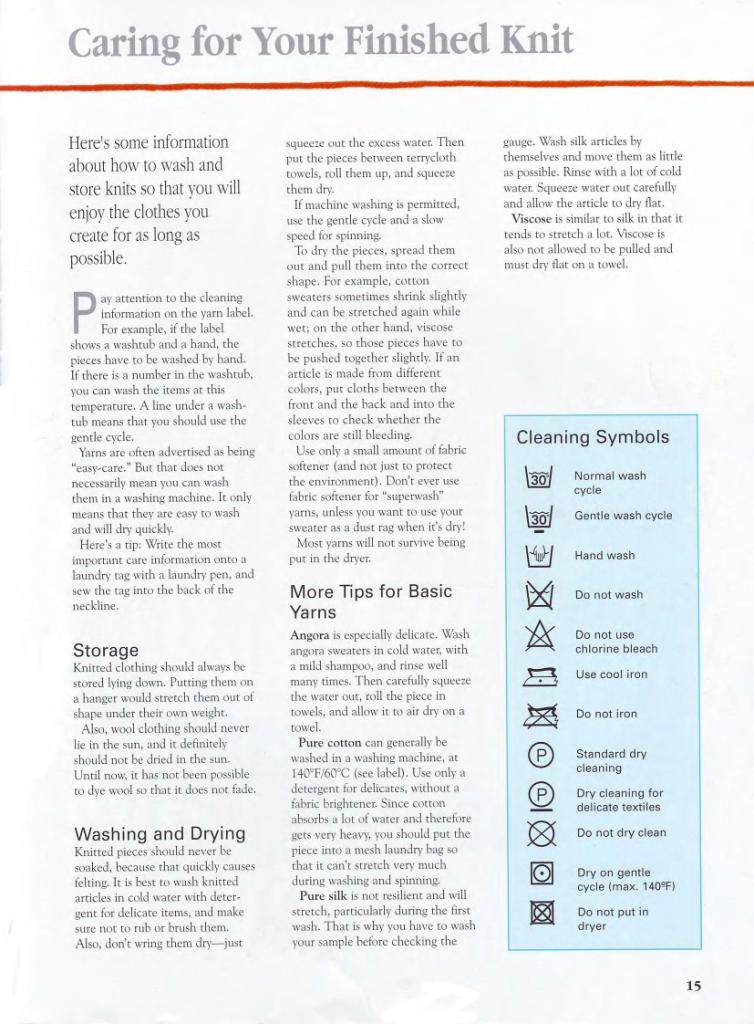015

Caring for Your Finished Knit
i lere's sonie inlbrmation about how to wash and storę knits so that you will enjoy the clothes you create for as long as

Pay attontton to the cleaning Information on the yarn label. For cxnmplc, if the labcl shows a washtub and a hand, the pieccs have to be wnshcd by Imiul.
Ił there i' a number in the washtub, you can wash the items at this temperaturę. A linę under a washtub mcans that you should use the goncie cyc te.
Yarns are often advcrtised as being “easy-care.* But that does not ncccssarily mean you can wash them m a washing machinę. It only means that rhev arc easy to wash and will dry ąutckly.
Here's a rip: Write the most important cate inlbrmation onto a laundry tag with a Inundry pen. and sow the tag into the bitek ul the neckline.
Storage
Knitted clothing should always bc storęJ lying down. Putting them on a hangęr would stretch them out of shnpc under their own weight.
Also, ui k«1 clothing should never lie in the sun, and it definitely should not be dried in the >un.
Unril nów, it has nor been pi*ssible to dyc wooł so tlv.it it does not ładę.
Washing and Drying
Knitted pieccs should nevcr be soaked. hecause that tjuickly causes feltiny. It is best to wash knitted arricles in cold water with detergent for dclicntc items. and make surę not co rub or brush them.
Also. don’r w ring them dry- just squee:e out the cxccs$ water. Tlten puc the piece< between tenycloth tou cis, roli them up, and >quce:e them dry.
If machinę washing is permitted. use the gen tle cycle and a slow speed for spinning.
To dry the pieccs. spread them out and puli them into the correct shape. For example, cotton sweaters sometimes shrink slightly and can be stretched agam while wet; on the other hand, viscose stretches. so those pieccs have to be pushed together slightly. If an arttclc ts madę from different colors, puc cloths between the front and the hack and into the slecvcs to check whether the Colors are still bleeding.
Use onlv a smali amount of fabric softener (and not just to protect the cnvironment). LV>n'r ever use fabric softener for "superwash” yarns, unless you want to use your swcater as a dust rag when it's dry!
Most yarns will not sumve being put in the dryer.
Morę Tips for Basic Yarns
Angora is especially delicatc. Wash angora sweaters in cold water. with a mlld shampoo, and rinse wcll many times. Then carehilly squee:e the water out, roli the piece in towels, and allow it to air dry on a towel.
Furę cotton can generally Fe washed in j washing machinę, at 140T.6C Y' (see label). Use only i detergent for dclicatcs, without a fabric bnghtener. Since cotton ahsorbs a lot oł water and therefore gets vcry heaw, you should put the piece into a mesh Inundry bag so that it cant stretch very much during washing and spinning.
Pure silk i> not icsilicnt and will stretch, partkularly during the łirst wash. Tltat i> why you have to wash your sample before checking the gauge. W ash silk articics by themselves anJ move them as lirrle as possible. Rinse with a lot of cold water. Squee:e water out carefully and allow the article to dry łlat.
Viscose U similar to silk in that it tends to stretch o lot. Visco*e is also not all- wed to be pulled and mmt dry flar on a towel.
Cleaning Symbols
1301
\Ęl
®
Normal wash cycle
Gontle wash cycle Hand wash Do not wash
Do not use chłonne bleach
Usc cool iron
Do not iron
Standard dry cleaning
Dry cleaning for delicate textiles
Do not dry clean
Dry on gentle cycle (max. 140*F1
Do not put in dryer
15
Wyszukiwarka
Podobne podstrony:
For pieces knit on the diagonal. a facing is easier to work and also morę anractive if you croc
8 11 SOME H1NTS ABOUT HOW TO KEEP A GOOD EYE CONTACT: • look in your interlocutor
ipe 46 T 91. Double the ropę loop so that you hołd the upper pole at your thi
Download Katarzyna Baranowska PDF eBooks Free things of your life and change the things that you can
Download Katarzyna Baranowska PDF eBooks Free things of your life and change the things that you can
About Advisors Advisors arc powcrful tools for database managcment. Thcy providc spccific advicc on
Szydełkowe kapelusze15 HOW TO BŁOCK AND SIZE YOUR COMPLETED CROCHET ► ■> GELATINET fi 1 Material
Managing your health care just got easier!Our new installable app is easy to use, and has convenient
CCF20110223�004 Drawing on your past experience and your expemtions list the advanmges of knowing ho
WELCOME to your custom prospectus for Wrocław University of Technology. It contains information rele
j045 KUKI yOU RZALLy CANT RIP OF youR £MOTIONS FOR yOUR This image is hosted at mangafox.c
How to Get Your First Real Copywriting Client in..."14 Days Or Less!" Discover My Personal
więcej podobnych podstron